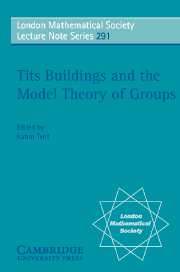Book contents
- Frontmatter
- Contents
- Preface
- List of speakers and talks
- Basics on buildings
- An introduction to generalized polygons
- Buildings and classical groups
- Twin buildings
- Twin trees and twin buildings
- Simple groups of finite Morley rank of even type
- BN-pairs and groups of finite Morley rank
- CM-trivial stable groups
- Amalgames de Hrushovski: Une tentative de classification
- Rank and homogeneous structures
- Constructions of semilinear towers of Steiner systems
- Introduction to the Lascar Group
Basics on buildings
Published online by Cambridge University Press: 12 January 2010
- Frontmatter
- Contents
- Preface
- List of speakers and talks
- Basics on buildings
- An introduction to generalized polygons
- Buildings and classical groups
- Twin buildings
- Twin trees and twin buildings
- Simple groups of finite Morley rank of even type
- BN-pairs and groups of finite Morley rank
- CM-trivial stable groups
- Amalgames de Hrushovski: Une tentative de classification
- Rank and homogeneous structures
- Constructions of semilinear towers of Steiner systems
- Introduction to the Lascar Group
Summary
This is an introductory survey on buildings for non-specialists. Buildings are natural (and far-reaching) generalizations of projective spaces, so we first look at projective planes and projective spaces from this point of view. We give a general definition of buildings as sets with a kind of distance function which takes its values in a Coxeter group. Then we state the fundamental and definitive classification results obtained by Jacques Tits. The Moufang condition is a strong geometric homogeneity condition for buildings, which arises in connection with Tits' classification. We also consider BN-pairs in groups, which correspond to a weaker homogeneity condition for buildings. In an appendix, we indicate various other possibilities to define buildings.
Historically, buildings have been introduced by Tits in order to give geometric interpretations of all simple Lie groups, including the exceptional types. It turned out that buildings are relevant also for the classification of simple algebraic groups and in other areas of mathematics; here we just mention Mostow's rigidity theorem, the classification of isoparametric submanifolds by Thorbergsson, and the proof of a conjecture of Margulis (about the asymptotic geometry of symmetric spaces of non-compact type) by Kleiner-Leeb; see also. For applications of buildings in model theory see Tent.
Projective planes and projective spaces
Incidence structures are triples (P, L, Δ) of sets with Δ ⊆ P × L; the elements of P are called points, the elements of L are called lines, and the relation Δ describes the incidence: (p, L) ∈ Δ means that the point p is on the line L (and then (p, L) is called a flag).
- Type
- Chapter
- Information
- Tits Buildings and the Model Theory of Groups , pp. 1 - 22Publisher: Cambridge University PressPrint publication year: 2002



